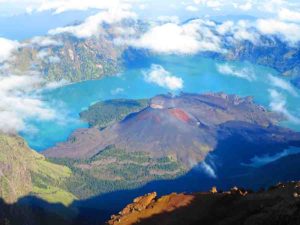
In recent weeks, the volcanic island of Lombok, in Indonesia, has been battered by a series of powerful earthquakes, each greater than M6 and each located deep beneath Lombok’s volcanic complex. The very presence of the volcano naturally leads to public concerns that these earthquakes are in some way related and we could expect an eruption to follow.
Lombok, a popular tourist destination for many Australians, shot to worldwide attention when two devastating quakes killed nearly 500 people (the first M6.4 on 29 July and the second almost M7 on 5 August). Pictures were seen on Australian media of clearly distressed Aussies queuing at the airport to get out as quickly as possible.
The reality on the ground, however, was far worse, with reports of more than 350,000 people displaced by the quakes. On 19 August, two more large earthquakes rocked the island, the first M6.3 and the second even larger at M6.9.
For those who live through earthquakes, the greatest anxieties often come from the long, drawn-out period of aftershocks that follow the main event. Many Indonesians have been living in makeshift shelters, uncertain of whether their homes are structurally stable, and painfully aware that fresh, damaging quakes happen any moment.
In the ring of fire
Lombok is perhaps not as well-known as its western neighbour, Bali, but remains a beautiful destination of choice. This island, like many of the Indonesian archipelago, lies on the infamous ring of fire. Just south of Lombok, tectonic plates are colliding at some of the fastest rates in the world (greater than 7cm per year), in a process known as subduction, where one plate slides under the other deep into the mantle. It’s the stresses from subduction that causes many earthquakes to occur, and it’s the heating up of the subducting plate and subsequent melting that leads to many volcanoes on the overlying plate.
As a result, Indonesia is used to both earthquakes and volcanic activity. On Lombok, the Rinjani volcanic complex rises on the northeastern side of the island, and indeed its natural beauty is one of the features that attracts tourists to the island.
Unfortunately, this particular volcanic complex also has some infamy. Mount Samalas, which is part of the complex, is thought to have erupted in 1275 with an explosion more powerful than Krakatoa – possibly triggering the northern hemisphere’s Little Ice Age.
The question of whether the earthquakes could signify a pending volcanic eruption is no small matter. We have no reliable method of predicting when a volcanic eruption or an earthquake will occur, due to the complexity of the Earth.
Nonetheless, we can look for clues. Earthquakes have been known to trigger or at least predate small eruptions.
Some concentrated sequences of earthquakes are also thought to track the movement of molten rock through the Earth. In this case, the earthquakes are somewhat unusual. In a standard earthquake sequence we expect the first earthquake, the mainshock, to be followed by a series of aftershocks of smaller magnitudes that tail off with time.
However, here, the first M6.4 earthquake was followed by a larger M6.9 earthquake, and a fortnight later two other earthquakes of similar magnitude. Each of these earthquakes was at different depths within the crust but at roughly the same location, on the northeastern side of Lombok, almost directly beneath Rinjani.
Key indicators
Thankfully, before anyone leaps to conclusions, we can use some of the outstanding global datasets that geoscientists collect to infer whether these earthquakes are indicators of magma rising into Rinjani.
First of all, there’s no obvious vertical time progression of seismicity that could indicate rising magma. Instead, the aftershocks from this earthquake sequence appear to be migrating laterally away from Lombok towards the east and the neighbouring island of Sumbawa.
Secondly, we can examine seismic signals from the earthquakes and determine how much fault slip is occurring relative to fault opening, using what scientists refer to as moment tensor solutions. This isn’t an exact science, but if magma were triggering the earthquakes we may expect to see some component of opening on the faults. In this case the moment tensor solutions seem to show the faults were mostly purely slipping.
Finally, the orientations of the faults hosting the earthquakes and the direction they slipped in are all consistent with the regional stress state caused by subduction, and could easily just be stress-triggered events rather than anything to do with magma.
For the moment, this series of earthquakes remains an alarming but mysterious sequence. The key thing now is for the local and international authorities to be allowed to carefully monitor the situation.
We have a number of tools at our disposal that help. These include looking for increases in gas emissions at Mount Rinjani, and using instruments such as tiltmeters to check whether ground deformation is occurring.
We hope these events will indeed die down and life for the locals can return to normal, with the support of the Indonesian government and international aid, including Australia’s. One day I hope to visit Lombok and climb its mountains, to see one of the Earth’s great wonders sleeping.
Note: The above post is reprinted from materials provided by Monash University.










